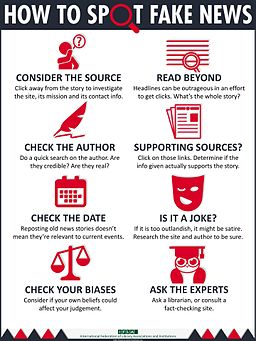The CRAAP Test
The C.R.A.A.P. Test
There are many tools and methods designed to help information users remember what criteria can be used to evaluate sources. One of these, the CRAAP test, provides you with five evaluative criteria that you can use when faced with a piece of information. Ask yourself the questions that align with each criterion as you begin to find and use information for your research project.

-
CRAAP TestDownload a PDF of the CRAAP test to use while evaluating your sources.
Evaluating Websites
Evaluating Websites
While the CRAAP criteria can help you evaluate information you've found online, websites have an additional characteristic to assist you in the evaluation process: domains.
The domain of a website gives important clues to its credibility. You can find the domain name, sometimes called the domain suffix, in the URL of the website – it’s the .com in amazon.com, and the .edu in salve.edu. Domain names follow patterns established by domain name registering agencies, and you can use those patterns to discern clues about the purpose and geographic origin of a website.
Some domains are better sources for credible information. For example, websites containing .edu or .gov originate from accredited postsecondary educational institutions or US government offices. As such, they are usually more credible than .com or .cc websites that may have a commercial focus.
A confusing domain is .org. This domain is available to non-profit and for-profit organizations. While non-profit implies the organization does not have a commercial interest, it still could have biased or inaccurate information to further their agenda.
Here are some general domain guidelines you can use in conjunction with other CRAAP criteria to evaluate a given website:
Credible Domains
| ✓.edu | ✓.gov | ✓.int | ✓.mil | ✓ac.uk |
Questionable Domains
| ? .org | ? .com | ? .cc | ? .co |
| ? .net | ? .ca | ? .us | ? .biz |
Remember, you should never rely only on a domain name to evaluate a source. Below is Indiana University East Campus Library's sample evaluation of a website that claimed the earth is hollow.

SIFT: The Four Moves to Web Evaluation
S.I.F.T. is a helpful acronym for initially evaluating source credibility. SIFT (from Mike Caulfield) stands for:
STOP. Pause and ask yourself if you recognize the information source and if you know anything about the website or the claim's reputation. If not, use the four moves (below) to learn more. If you start getting too overwhelmed during the other moves, pause and remember your original purpose.
INVESTIGATE the source. Take a minute to identify where this information comes from and to consider the creator's expertise and agenda. Is this source worth your time? Look at what others have said about the source to help with you these questions. (For example, a company that sells personal care products is not the best source for information about the benefits/risks of using hair dye. A research study funded by a company associated with that product or brand is also suspect.)
FIND trusted coverage. Sometimes it's less important to know about the source and more important to assess their claim. Look for credible sources; compare information across sources and determine whether there appears to be a consensus.
TRACE claims, quotes, and media back to the original context. Sometimes online information has been removed from its original context (for example, a news story is reported on another online publication or an image is shared on Instagram). If needed, trace the information back to the original source in order to re-contextualize it.
Modified from Mike Caulfield's SIFT (Four Moves), which is licensed under a Creative Commons Attribution 4.0 International License.
There are many ways to "S.I.F.T" information (as described above). The following "four moves" from Web Literacy for Student Fact-Checkers will help:
When you first come across a web source, do a quick initial assessment, much like a fact-checker does. Fact-checkers don't spend too much time on a website; instead they quickly leave that site to see what others have said about the site.
- "Check for previous work.": Has someone already fact-checked the claim or analyzed the research?
(Search the Internet for other coverage on the claim. Consider where that coverage comes from.) - "Go upstream to the source.": Is this the original source of the information, or is this a re-publication or an interpretation of previously published work? Are you examining the original source? If not, trace back to it.
- "Read laterally.": What are others saying about the original source (publication, author, topic, etc.) and/or about its claim?"The truth is in the network."
- "Circle back.": If you hit a dead road, what other search terms or strategies might lead you to the information that you need?
Later, if you determine that the site is worth your time, you can analyze the source's content more carefully.
(Adapted from “Four Moves, Web Literacy for Student Fact-Checkers”, Mike Caulfield)

